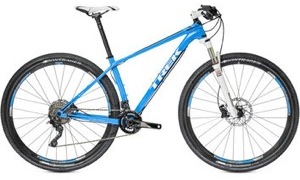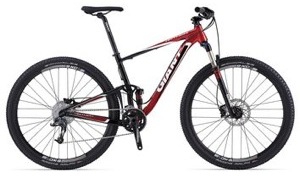
There are so many bikes to choose from when it comes to finding the right one for your next off-road adventure. Within every brand are certain disciplines of Mountain Bikes (MTB), targeted at all the styles within off-road riding. From Enduro to Cross Country, to all out Downhill - the choices are endless.
In this article, we are focusing on just one style of bike - Cross Country (XC). But within this one style, we are going to zoom in on whether you should go for a hardtail version or a softail / dual suspension version of any given bike. From there, all you need to do is choose the color!
Each of these sub styles of bike do have their clear advantages, but in very specific circumstances. For example; a dual suspension bike might be better for descending but not so perfect for a 50km Cross Country race with fairly mild terrain. So before you choose the bike you need to choose your riding style...
NOTE: Everyone has their own style and opinion of what suits them. This is just a 'middleman' view on both options so please keep that in mind when commenting below!
Cycling Experience: Check out "Dual suspension story by a try hard whippet" for a personal experience regarding choosing between these mountain bikes.
HARDTAIL
Hardtail is the original mountain bike style, dating back to when off-road riding was done on any sort of bike really... Then front suspension was added, and that was seen as sufficient technological advancement. Today's hardtail MTB rigs are at the cutting edge of technology, and are often the preferred choice of Elite racers worldwide.
Benefits

Always lighter than a dual suspension bike, and slightly stiffer in the rear triangle (which directly affects lateral stiffness and subsequently acceleration). Hardtail bikes are financially, the preferred choice for people getting into mountain bike riding. You definitely get more bang for your buck with regards to component quality on a hardtail, which is an important consideration when the budget is tight.
From a performance point of view, they do climb substantially better than a dual suspension bike, depending on which side of the fence you sit, and how good a climber you are.
Given the inclusion of 29 inch wheels, the benefits of a hardtail have been enhanced to also include the ability to soak up smaller bumps much better than their smaller 26" and 27.5" rivals. Once again, which side of the fence are you on?
Limitations
Like anything, a hardtail MTB has a purpose. If you ride the bike outside of its comfort zone it's not going to do as well as you may have hoped. Hardtail mountain bike rigs are not the best bike for rough descents or technical trails.
The reason for this is obvious - there's a lot more impact and shock coming through the bike from the rear end because there's no suspension to absorb it. A skilled rider can keep up on a hardtail, or at least minimize their losses before rocketing away on the next climb.
A cross country hardtail bike is made specifically for cross country trails. This means a trail that includes rock gardens, logs, drop offs and bridges. All stuff a hardtail can handle when ridden correctly. More importantly, a hardtail is designed to be lightweight and to be ridden uphill fast. Cross country in its original 'Olympic' format always has lots of hills.
If you ride such trails, or ride at a moderate pace - consider a well-equipped hardtail MTB.
Example: 2014 Trek Superfly 7
DUAL SUSPENSION
The kind of bike you buy because you don't know exactly what you'll be riding. A dual suspension bike is designed to open your riding horizon up to include the normal cross country trails, as well as some rougher stuff! Dual suspension bikes have an enormous array of styles, and sub styles - but we are referring specifically to Cross Country dual suspension bikes (the lightweight version of their burly brothers).
Benefits

The benefits of a dual suspension bike lie within their versatility. The ability to ride the most amount of terrain without sacrificing too many performance points along the way. A cross country dual suspension bike is best for long distance MTB rides or races, as the bike does most of the work for you (compared to a hardtail, that is). The rear suspension not only absorbs a lot of the impacts you receive, but also keeps your wheel in contact with the ground when you hit the rough stuff.
From long and technical descents through to rough climbs, a dual suspension will help you out the most. As far as climbing goes, some high-end dual suspension bikes do offer complete rear suspension lockout. However you have to spend big to obtain that feature on most bikes.
Example: 2014 Giant Anthem X 29er 2
![]() Side by side comparison: Hardtail vs dual suspension
Side by side comparison: Hardtail vs dual suspension
Limitations
Unfortunately dual suspension bikes do have their own limitations. They aren't as obvious as a hardtail's limitations, but they're still there. A dual suspension bike of any level will always weigh more than its exact hardtail counterpart. So if you're in the weight game, this will steer you towards a hardtail.
Dual suspension bikes are also slightly more costly to maintain, purely because you now have an extra rear shock to service, as well as the need to replace all the linkage points and bearings every so often.
A slightly more obscure downside to riding a dual suspension bike is that new riders quickly learn to let the bike do all the work. They slam over logs and jack hammer through rock gardens knowing the bike will do the work for them. In the interest of developing a smooth and efficient riding style, it might be best to avoid a dual suspension bike at first, and graduate to it later, as you can arguably developer a better foundation for your skills riding a hardtail...
As far as versatility goes, dual suspension bikes usually win hands down. So if you plan on mixing it up, you'll no doubt be riding a dual suspension setup soon!
Now, about that fence!


